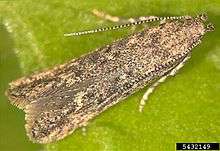Tuta absoluta
Tuta absoluta is a species of moth in family Gelechiidae known by the common names tomato leafminer, tomato pinworm and South American tomato moth. It is well known as a serious pest of tomato crops in Europe, Africa, western Asia and South and Central America. T. absoluta was originally described in 1917 by Meyrick as Phthorimaea absoluta, based on individuals collected from Huancayo (Peru). Later, the pest was reported as Gnorimoschema absoluta[1], Scrobipalpula absoluta (Povolny), or Scrobipalpuloides absoluta (Povolny), but was finally described under the genus Tuta as T. absoluta by Povolny in 1994[2]. Its life-cycle comprises four development stages: egg, larva, pupa and adult. Adults usually lay eggs on the underside of leaves or stems, and to a lesser extent on fruits. After hatching, young larvae penetrate leaves, aerial fruits (like tomato) or stems, on which they feed and develop. Pupae (length: 5–6 mm) are cylindrical in shape and greenish when just formed becoming darker in colour as they are near adult emergence. Adults are 6–7 mm in length and present filiform antennae and silver to grey scales [3]. Black spots are present on anterior wings, and the females are wider and more voluminous than the males. The pest mainly presents nocturnal habits, and adults usually remain hidden during the day, showing greater morning-crepuscular activity with adults dispersing among crops by flying. Among a range of species within the Solanaceae, tomatoes (Lycopersicon esculentum Miller) appear to be the primary host of T. absoluta.
| Tuta absoluta | |
|---|---|
 | |
| Scientific classification | |
| Kingdom: | |
| Phylum: | |
| Class: | |
| Order: | |
| Family: | |
| Genus: | |
| Species: | T. absoluta |
| Binomial name | |
| Tuta absoluta (Meyrick, 1917) | |
| Synonyms | |
| |
Biology
The larva feeds voraciously upon tomato plants, producing large galleries in leaves, burrowing in stalks, and consuming apical buds and green and ripe fruits. It is capable of causing a yield loss of 100%.[4]
Tomato is the main host plant, but T. absoluta also attacks other crop plants of the nightshade family, including potato, eggplant, pepino, pepper and tobacco.[5] It is known from many solanaceous weeds, including Datura stramonium, Lycium chilense, and Solanum nigrum.
The adult moth has a wingspan around one centimeter. In favorable weather conditions eight to ten generations can occur in a single year.
Global spread
This moth was first known as a tomato pest in many South American countries. In 2006, it was identified in Spain [6]. The following year it was detected in France, Italy, Greece, Malta, Morocco, Algeria and Libya. In 2009 it was first reported from Turkey. The advance of T. absoluta continued to the east to reach Syria, Lebanon, Jordan, Israel, Iraq and Iran. Further advances southward reached Saudi Arabia, Yemen, Oman and the rest of the Persian Gulf states. In Africa, T. absoluta moved from Egypt to reach Sudan, South Sudan and Ethiopia from the east and to reach the Senegal from the west. It was reported in Nigeria and Zambia [7] in 2016. An up-to-date global distribution map is available on the Tuta absoluta information network.In India, Maharashtra state tomato cultivation more affect in Nov.2016. Recently, this pest has been identified from several districts of Nepal [8] It is now severely infested in Myanmar, especially in tropical tomato growing areas such as Mandalay, Sagaing, Monywa.( April, 2017)
Management
Some populations of T. absoluta have developed resistance to organophosphate and pyrethroid pesticides.[9] Newer compounds such as spinosad [10], imidacloprid, and Bacillus thuringiensis[11] have demonstrated some efficacy in controlling European outbreaks of this moth.
Experiments have revealed some promising agents of biological pest control for this moth, including Nabis pseudoferus, a species of damsel bug.[12]
The sex pheromone for T. absoluta has been identified by researchers at Cornell University and has been found to be highly attractive to male moths.[13] Pheromone lures are used extensively throughout Europe, South America, North Africa and the Middle East for the monitoring and mass-trapping of T. absoluta. The use of Pheromone products in combination with a yellow delta trap has been recorded in South Africa. This concept is used to monitor populations of T. absoluta in tomato orchards[14].
The combined use of pheromones as well as specific light frequency proved to be effective in suppressing the T. absoluta population and keeping it within the economic threshold as it disclosed by Russell IPM in a United Kingdom patent.[15]
Also the use of electric mosquito traps give good results[16].

References
- Clarke JF (1962) New species of microlepidoptera from Japan. Entomol News 73:102
- Barrientos ZR, Apablaza HJ, Norero SA, Estay PP (1998) Temperatura base y constante térrmica de desarrollo de la polilla del tomate, Tuta absoluta (Lepidoptera: Gelechiidae). Ciencia e Investigación Agraria 25:133–137
- Coelho MCF, Franc¸a FH (1987) Biologia e quemotaxia da larva e descrição da pupa e adulto da traça-do-tomateiro. Pesqui Agropecu Bras 22:129–135
- Apablaza J, 1992. La polilla del tomate y su manejo. Tattersal 79, 12–13.
- Desneux, Nicolas (2010). "Biological invasion of European crops by Tuta abosluta: ecology, geographic expansion and prospects for biological control". Journal of Pest Science. 83 (3): 197–215. CiteSeerX 10.1.1.470.970. doi:10.1007/s10340-010-0321-6.
- Urbaneja A, Vercher R, Navarro V, García Marí F, Porcuna JL (2007) La polilla del tomate, Tuta absoluta. Phytoma España 194:16–23.
- "Bloomberg - Are you a robot?".
- Ajaya Shree Ranta Bajracharya, Ram Prasad Mainali, Binu Bhat,Sanjaya Bista, Pathour R Shashank and Naresh Manohar Meshramhttp://www.entomoljournal.com/archives/2016/vol4issue4/PartO/4-4-95-749.pdf The first record of South American tomato leafminer, Tuta absoluta (Meyrick 1917)(Lepidoptera: Gelechiidae) in Nepal
- Lietti, M. M. M., E. Botto, and R. A. Alzogaray. 2005. Insecticide Resistance in Argentine Populations of Tuta absoluta (Meyrick) (Lepidoptera: Gelechiidae). Neotropical Entomology 34(1):113-119.
- Campos MR, Rodrigues ARS, Silva WM, Silva TBM, Silva VRF, Guedes RNC, et al. (2014) Spinosad and the Tomato Borer Tuta absoluta: A Bioinsecticide, an Invasive Pest Threat, and High Insecticide Resistance. PLoS ONE 9(8): e103235. https://doi.org/10.1371/journal.pone.0103235.
- Gonzalez-Cabrera J, Molla O, Monton H, Urbaneja A. 2011. Efficacy of Bacillus thuringiensis (Berliner) for controlling the tomato borer, Tuta absoluta (Meyrick) (Lepidoptera: Gelechiidae). Biocontrol 56, 71–80.
- Molla O, Gonzalez-Cabrera J, Urbaneja A. 2011. The combined use of Bacillus thuringiensis and Nesidiocoris tenuis against the tomato borer Tuta absoluta. Biocontrol. (in press).
- http://www.cctec.cornell.edu/technology/products/iscalure-web.pdf
- "T.A. PheroLure ® - Insect Science". Insect Science. Retrieved 2018-04-29.
- United Kingdom Patent No. GB2474274
- Coltivazione Biologica (2016-06-18). "Come eliminare la tuta absoluta del pomodoro in modo biologico". Coltivazione Biologica (in Italian). Retrieved 2019-09-12.
- "T.A. PheroLure ® - Insect Science". Insect Science. Retrieved 2018-04-29.
External links
- Tuta absoluta information network
- EPPO Gallery Tuta absoluta
- YouTube Tuta absoluta cicle biològic en tomàquet- Short movie of development
- Tuta absoluta Agrotypos S.A. video (in Greek)
- Tuta absoluta Agrotypos S.A. article (in Greek)
- Video "Living with Tuta absoluta" Proposed Management Strategy ( in English)
- Video "Living with Tuta absoluta" Proposed Management Strategy ( in Arabic)